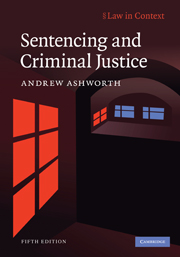Book contents
- Frontmatter
- Contents
- Preface
- Table of legislative measures
- Table of cases
- 1 An introduction to English sentencing
- 2 Sentencing and the constitution
- 3 Sentencing aims, principles and policies
- 4 Elements of proportionality
- 5 Aggravation and mitigation
- 6 Persistence, prevention and prediction
- 7 Equality before the law
- 8 Multiple offenders
- 9 Custodial sentencing
- 10 Non-custodial sentencing
- 11 Procedural issues and ancillary orders
- 12 Special sentencing powers
- 13 Conclusions
- Appendix: The Sentencing Council: provisions in the Coroners and Justice Act 2009
- References
- Index
8 - Multiple offenders
Published online by Cambridge University Press: 05 June 2012
- Frontmatter
- Contents
- Preface
- Table of legislative measures
- Table of cases
- 1 An introduction to English sentencing
- 2 Sentencing and the constitution
- 3 Sentencing aims, principles and policies
- 4 Elements of proportionality
- 5 Aggravation and mitigation
- 6 Persistence, prevention and prediction
- 7 Equality before the law
- 8 Multiple offenders
- 9 Custodial sentencing
- 10 Non-custodial sentencing
- 11 Procedural issues and ancillary orders
- 12 Special sentencing powers
- 13 Conclusions
- Appendix: The Sentencing Council: provisions in the Coroners and Justice Act 2009
- References
- Index
Summary
This chapter, like Chapter 6, deals with some of the problems posed by the sentencing of persistent offenders. Its focus, however, is on offenders who come before the courts in a different context. In Chapter 6 the main concern was with the sentencing of recidivists – those who are convicted repeatedly, despite the fact that they have experienced criminal sanctions. The main concern here is with offenders who commit a number of offences before they are detected and convicted, so that the court has to sentence them on one occasion for several offences. Not all the offenders whom the courts have to sentence for several crimes could be described as ‘persistent offenders’, for in some cases the offender has been involved in a single incident which gives rise to a number of charges and convictions. But many ‘multiple offenders’, whom the courts have to sentence for more than one offence, are people who have been committing offences over a period of weeks, months or even years before they appear in court, and they then face a number of charges. The criminal record of such multiple offenders may vary: some of them will be recidivists too, having experienced a number of criminal sanctions in the past, whilst others will fall into that seemingly incongruous category of ‘persistent first offenders’ – those who, when they are convicted for the first time, are convicted of several offences which show that they are accustomed to lawbreaking, if not to the criminal process.
- Type
- Chapter
- Information
- Sentencing and Criminal Justice , pp. 260 - 277Publisher: Cambridge University PressPrint publication year: 2010

